Ally Pally Woodworking Questions-Saws
Q: We saw your demonstrations and they were great. I wondered if you could guide me on which saw to buy for making dovetails?
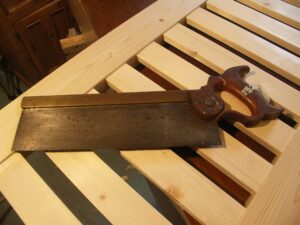
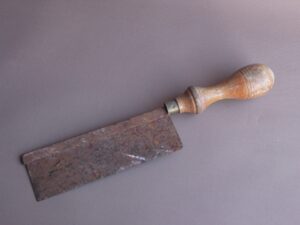
A: A problem I saw (no pun) at the show is that most people there are divided into two categories: On the one side you have people looking for information, while on the other you have people supplying information. Now you don’t have to wander too far from the tree to realise that most of the information is not unbiased and it’s not simply to present facts either. Naturally it’s to promote product in such a way that those looking for the information are indeed persuaded to buy. So, if you make saws, you present information about your saw in the best light. You take the saw, offer it to the wood, slice-cut a few strokes and hopefully make a sale. What the salesman/woman rarely tells you is that repeated cuts over a month or two dulls the saw and the saw therefor requires sharpening. That’s a fact no matter how hard the teeth are. So, no matter how well the teeth are sharpened, or how finely set, when you buy a saw you are buying into a lifetime of sharpening. In my view, though it’s nice to own a new, no-problems saw, they must be sharpened and sharpened all too soon after buying them. Anyone who tells you that a saw will stay sharp for two years is really telling you that you won’t be doing very much with it. I expect my saws to stay sharp for about two months of daily use. If I leave it longer, the tooth condition worsens and I have to file more strokes to reestablish the edge I need on each tooth. The saw above right is a great saw designed and made by Veritas. I can recommend it if you are wanting a new saw, off the shelf, ready to go, moderately priced (from www.classichandtools.co.uk) that needs no restorative work to begin with. Buy the rip version. You won’t need the crosscut. Now, remember, “Restoration is always a sign of neglect, good maintenance prevents restoration.” (Copyright: Paul Sellers 2002)

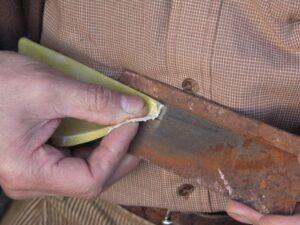
Now here is the fact. I have bought 30-40 saws over the past 18-months, most of them used. I use them for teaching saw sharpening and also to use at the school. Most of them I buy from local car boot sales and flea markets. Some I buy on eBay too. I rarely pay more than £5 for a saw from such places and most often I buy them for 50p. I will pay £50 for a good, old Groves brass-backed tenon saw, or a Disston tenon or dovetail saw, but they must be good ones for me to pay that much; no pitting in the steel or creases or cracked or broken handles. These saws are often far superior to modern saws and can be had for pennies plus a saw file. I sharpen any hand saw in four minutes. If the teeth need reshaping it takes two minutes more. Topping (jointing) takes one more minute. Rust removal is simply a case of going through varying levels of abrasive paper (wet n dry) to 350-grit starting with 120-grit. 20- minutes should deal with this. A saw file must be sized to suit the tooth size of the saw. For teeth smaller than 9-ppi (point per inch) a 4-6″ double slim extra fine file works well. There is a lot more information on this if you want to email me: [email protected].
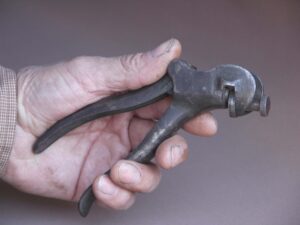
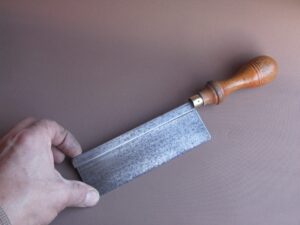
By now you will gather that I like old saws that have all trace of machine processing knocked off. You must face sharpening as soon as you can so why not start now. Saw makers and salesmen can only talk about the needs, they usually have no background in the essentials. Buy an old saw, take a few swipes across the teeth and think the process through. I bought two pairs of sawsets from a car boot sale for £3 for one and 50p for another. They don’t come up too often. But even buying new will cost you about £15 and they last for years. I have had mine for 46 years now. These ‘inline’ saws work well and are cheaper new or old.
READY, (SAW) SET GO?


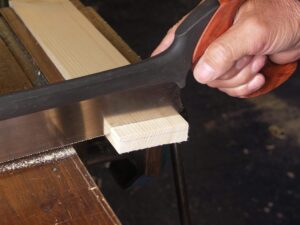
Hello Paul,
thank you very much for sharing your knowledge! My girlfriend recently said: “You love your woodworking more than me”. I hope it’s not the truth .I’m a new to woodworking and I have a question on saws. Some days ago, I bought a new tenon saw (Thomas Flinn, rip, 13 tpi) and thought I might be able to use it with and across the grain. In reality, the fibers tear out and the saw doesn’t move freely when I’m trying to cut across the grain.
Am I supposed to change the set to use it in both directions or what would you recommend? I only own a nailset and a sawfile – no sawset.
Thank you very much and best regards
Florian Eisele